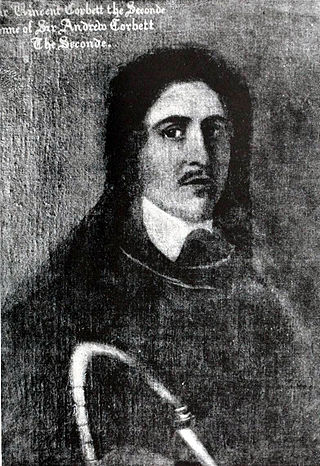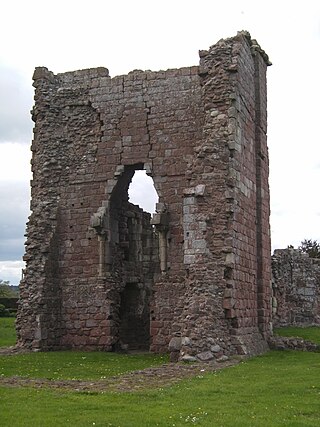Related Research Articles

Ellesmere is a town in Shropshire, England, located near the Welsh border and the towns of Oswestry and Whitchurch, and the Welsh city of Wrexham. It is notable for its proximity to a number of prominent Meres.

Roger Mortimer, 1st Baron Mortimer of Wigmore, of Wigmore Castle in Herefordshire, was a marcher lord who was a loyal ally of King Henry III of England and at times an enemy, at times an ally, of Llywelyn ap Gruffudd, Prince of Wales.
Earl of Bradford is a title that has been created twice, once in the Peerage of England and once in the Peerage of the United Kingdom. It was first created in 1694 for Francis Newport, 2nd Baron Newport. However, all the Newport titles became extinct on the death of the fourth Earl in 1762. The earldom was revived in 1815 for Orlando Bridgeman, 2nd Baron Bradford. The Bridgeman family had previously succeeded to the Newport estates. The title of the peerage refers to the ancient hundred of Bradford in Shropshire, and not, as might be assumed, to the city of Bradford, Yorkshire, or the town of Bradford-on-Avon in Wiltshire.
Shropshire was established during the division of Saxon Mercia into shires in the 10th century. It is first mentioned in 1006. After the Norman Conquest it experienced significant development, following the granting of the principal estates of the county to eminent Normans, such as Roger De Montgomery and his son Robert de Bellême.

Fulk FitzWarin, variant spellings, the third, was a prominent representative of a marcher family associated especially with estates in Shropshire and at Alveston in Gloucestershire. In young life, early in the reign of King John (1199–1216), he won notoriety as the outlawed leader of a roving force striving to recover his familial right to Whittington Castle in Shropshire, which John had granted away to a Welsh claimant. Progressively rehabilitated, and enjoying his lordship, he endured further setbacks in 1215–1217.
Gruffydd ap Gwenwynwyn was a Welsh king who was lord of the part of Powys known as Powys Wenwynwyn and sided with Edward I in his conquest of Wales of 1277 to 1283.
Roger le Strange, Baron Strange, also known as, Roger Lestrange or Roger Strange, Lord of Ellesmere, was an English knight, commander and royal advisor.
The Stanley family is an English family with many notable members, including the Earls of Derby and the Barons Audley who descended from the early holders of Audley and Stanley, Staffordshire. The two branches of the Audley family were made Barons Audley but both ended in the male line in the 14th century, after which their considerable estates were passed to a number of female heiresses, while the Stanleys would be elevated in the 15th century first to Barons Stanley and then Earls of Derby, a title they continue to hold.

John Charlton, 1st Baron Charlton of Powys (1268–1353) came from a family of minor landowners near Wellington, Shropshire. He was the son of Robert Charlton of Apley castle near Wrockwardine.
Edmund de Stafford, 1st Baron Stafford, was the son of Nicholas de Stafford, who was summoned to parliament by writ on 6 February 1299 by King Edward I.

Sir Vincent Corbet, 1st Baronet was an English lawyer and politician who sat for Shropshire in the House of Commons in the Short Parliament of 1640. He fought on the Royalist side in the English Civil War.
The Corbet family is an English family of Anglo-Norman extraction that became one of the most powerful and richest of the landed gentry in Shropshire. They trace their ancestry to two barons found in the 1086 Domesday Book and probably derive from the Brioton and Essay region, near Sées in Normandy. The name Corbet derives from the Anglo-Norman word corb, meaning "crow", matching the modern French corbeau. Variants of the name include: Corbet, Corbett, Corbitt, Corbit, Corbetts, Corbete, Corben and possibly the variant of Corbin. It has cognates in other languages: the Spanish name Cuervo, for example, which generally means a raven or rook. The underlying derivation is from the Latin word corvus, crow. Generally it is thought to be a jocular reference to a person who was thought to resemble a crow: in hair colour, tone of voice or shape of nose. However, the Scandinavians believed that a raven on the battlefield was a beneficial omen and ensured victory.

Sir Thomas Wolryche, 1st Baronet was an English landowner and politician who sat in the House of Commons for Wenlock between 1621 and 1625. He fought in the Royalist army in the English Civil War, serving as military governor of Bridgnorth.
William FitzAlan (1105–1160) was a nobleman of Breton ancestry. He was a major landowner, a Marcher lord with large holdings in Shropshire, where he was the Lord of Oswestry, as well as in Norfolk and Sussex. He took the side of Empress Matilda during the Anarchy and underwent considerable hardship in the Angevin cause before regaining his lands and former status. William's younger brother, Walter fitz Alan, became ancestor of the royal House of Stuart.
Roger Corbet (c.1501–1538) was an English politician and landowner of the Tudor Period. A member of the Shropshire landed gentry, he represented the Borough of Truro in the English Reformation Parliament.

Sir Roger Corbet, of Moreton Corbet, Shropshire was a landowner and politician who was a knight of the shire for Shropshire in three Parliaments of England. He was involved in a series of complex and sharply contested property disputes with members of his own family.
Robert Corbet (1383–1420) of Moreton Corbet, Shropshire, was an English soldier, politician and landowner who represented Shropshire twice in the House of Commons of England. A retainer of Thomas FitzAlan, 12th Earl of Arundel, and implicated in his alleged misrule in Shropshire, he accompanied his patron to the Siege of Harfleur and suffered a temporary eclipse after his death.

Roger Corbet was an English soldier, politician and landowner. He was a client of Thomas FitzAlan, 12th Earl of Arundel and was implicated in the disorder that accompanied Arundel's rule in Shropshire. He probably fought at the Battle of Agincourt. After the untimely death of his patron, he became a successful municipal politician at Shrewsbury and represented Shrewsbury twice and Shropshire once in the House of Commons of England.
John Darras (c.1355–1408) was an English soldier, politician and landowner, who fought in the Hundred Years' War and against the Glyndŵr Rising. A client of the FitzAlan Earls of Arundel, he served them in war and peace, helping consolidate their domination of his native county of Shropshire. He represented Shropshire twice in the House of Commons of England. He died by his own hand.
Hawise Lestrange was the daughter of the Marcher lord John Lestrange (d.1269) of Great Ness, Cheswardine and Knockin (Shropshire). Married at a young age to the ruler of southern Powys, Gruffudd ap Gwenwynwyn, she became a key figure in border affairs and in the management of her family and estates until her death at a great age. She was deeply implicated in a plot to overthrow the prince of Wales, Llywelyn ap Gruffudd, in 1274, and with her husband sided with Edward I in the English king's conquest of Wales.
References
- 1 2 3 4 5 6 7 8 9 10 11 12 13 Mason, J. F. A. (May 2005). "Lestrange [Le Strange], John (c. 1194–1269)". Oxford Dictionary of National Biography. Oxford Dictionary of National Biography (online ed.). Oxford University Press. doi:10.1093/ref:odnb/16510.(Subscription or UK public library membership required.)
- ↑ Proposed by Round ("The Origin of the Stewarts" in Studies in Peerage and Family History, p.122) and accepted by Hamon Le Strange (Le Strange Records, p.10.) and Keats-Rohan (Domesday Descendants, p.842).
- ↑ Proposed by Eyton, Antiquities of Shropshire Vol II p.8.
- ↑ Bodleian, MS Ashmole 1120, fo. 174r
- ↑ John Burke: A general and heraldic dictionary of the peerages of England, Ireland, and Scotland, extinct, dormant, and in abeyance. England . Oxford, 1831. S. 498